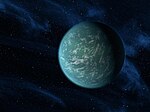WASP-48b
Appearance
| Orbital characteristics | |
|---|---|
| 0.03444 AU (5,152,000 km) | |
| 2.14363592±0.0000046[1] d | |
| Inclination | 80.09 +0.55−0.55 |
| Star | WASP-48 |
| Physical characteristics | |
| 1.485 ± 0.052RJ[2] | |
| Mass | 0.984±0.085[1] MJ |
| Temperature | 2300 |
WASP-48b is an extrasolar planet orbiting the star WASP-48 in the constellation Cygnus. The planet was detected using the transit method by the SuperWASP team, which published its discovery in 2011. It orbits its host star in just 2.14 days with a semi-major axis of 0.034 AU[3] and has an equilibrium temperature of 1956±54 K.[4] The dayside temperature was measured to be around 2300 K in 2018.[2]
The planetary atmosphere transmission spectrum is gray and featureless,[5] having no noticeable Rayleigh scattering.[4]
References
[edit]- ^ a b Turner, Jake D.; et al. (2016). "Ground-based near-UV observations of 15 transiting exoplanets: Constraints on their atmospheres and no evidence for asymmetrical transits". Monthly Notices of the Royal Astronomical Society. 459 (1): 789–819. arXiv:1603.02587. Bibcode:2016MNRAS.459..789T. doi:10.1093/mnras/stw574.
- ^ a b Clark, B. J. M.; Anderson, D. R.; Madhusudhan, N.; Hellier, C.; Smith, A. M. S.; Collier Cameron, A. (2018), "Thermal emission of WASP-48b in the Ks-band", Astronomy & Astrophysics, 615: A86, arXiv:1804.01913, Bibcode:2018A&A...615A..86C, doi:10.1051/0004-6361/201527071, S2CID 89607391
- ^ Enoch, B.; et al. (2011). "WASP-35b, WASP-48b, and HAT-P-30b/WASP-51b: Two New Planets and an Independent Discovery of a Hat Planet". The Astronomical Journal. 142 (3). 86. arXiv:1104.2827. Bibcode:2011AJ....142...86E. doi:10.1088/0004-6256/142/3/86. S2CID 63996398.
- ^ a b Ciceri, S.; Mancini, L.; Southworth, J.; Bruni, I.; Nikolov, N.; d'Ago, G.; Schröder, T.; Bozza, V.; Tregloan-Reed, J.; Henning, Th. (2015), "Physical properties of the HAT-P-23 and WASP-48 planetary systems from multi-colour photometry", Astronomy & Astrophysics, 577: A54, arXiv:1503.00762, Bibcode:2015A&A...577A..54C, doi:10.1051/0004-6361/201425449, S2CID 53607610
- ^ Murgas, F.; Pallé, E.; Parviainen, H.; Chen, G.; Nortmann, L.; Nowak, G.; Cabrera-Lavers, A.; Iro, N. (2017), "The GTC exoplanet transit spectroscopy survey", Astronomy & Astrophysics, 605: A114, arXiv:1707.03345, doi:10.1051/0004-6361/201730937, S2CID 55003393
External links
[edit]- "WASP-48". Retrieved 2013-06-02.
- "Differential Photometry - WASP-48 in Cygnus". Retrieved 2013-06-02.



